The Patriots have quietly mirrored the Red Sox’ blueprint of salvaging as much money as possible during the pandemic-plagued season.
We haven’t been able to say this many times (if at all) throughout the years, but it hasn’t been fun to be a Boston-based football and baseball fan this season. The Red Sox finished with the fourth-worst record in MLB this season and would’ve had a legitimate shot at eclipsing the century mark in losses had the campaign not been shortened due to the coronavirus pandemic.
The Patriots, meanwhile, continue to fall on their face and are currently on the periphery of the AFC playoff picture through six weeks. A blockbuster trade ahead of the Nov. 3 deadline might not even be enough to save head coach Bill Belichick’s side, which is in the midst of its first three-game losing streak in 18 years and just suffered its worst home loss since he took over coaching duties back in 2000.
Amazingly enough, however, those aren’t the only similarities the two storied franchises have shared this year. You know how the Red Sox did everything possible to avoid spending money between the start of last offseason and the end of the truncated 2020 campaign?
Well, the latest salary cap calculations prove that the Patriots embraced a similar blueprint to benefit from the pandemic-plagued season. As of this writing, New England is projected to have the fourth-most cap space ($62.6 million) in the NFL in 2021.
Teams with most projected NFL salary cap space in 2021 (inc. carryover)
— Jason_OTC (@Jason_OTC) October 25, 2020
1. Jaguars- $75M
2. Jets- $72.7M
3. Colts- $66.5M
4. Patriots- $62.6M
5. Football Team- $50.5M
6. Ravens- $30.9M
7. Dolphins- $33.6M
8. Bengals- $25.2M
9. Broncos- $24.5M
10. Browns- $22.9M
Let’s take a look at the Patriots’ recent activity, shall we? For starters, they inexplicably refused to give versatile offensive lineman Joe Thuney a contract extension despite the fact that he’s been their most reliable performer up front over the last four seasons. In a move that ensured he wouldn’t impact their cap situation next year, he was hit with a $14.78 million franchise tag back in March.
The Patriots followed that puzzling decision by letting Tom Brady test free agency for the first time in his career and ultimately signed Cam Newton for pennies on the dollar to be his heir apparent. Despite his recent poor form, that contract is an absolute bargain compared to what some lesser talented quarterbacks are being paid.
On top of that, the Patriots let a slew of fellow free agents walk and seemingly went out of their way to not find replacements for them during the extended offseason, relying on rookie draft picks and largely unknown commodities to fill their role instead.
If we’ve learned anything through the first six weeks, it’s that those young players — like wide receiver N’Keal Harry, linebacker Josh Uche and tight end tandem Dalton Keene and Devin Asiasi, to name a few — aren’t ready to be full-time starters just yet. Let’s keep in mind that those are the Patriots’ biggest positions of need right now and they are getting nothing out of those players.
Patriots rookie TE Devin Asiasi is a healthy scratch today. Dalton Keene takes his spot.
— Mike Reiss (@MikeReiss) October 25, 2020
We don’t need to dive into a detailed recap of the Red Sox’ latest transactions (or lack thereof), but their over-reliance on inexperienced players and tireless efforts to shed contracts — look no further than the all-time bad decision to trade superstar outfielder Mookie Betts, who’s performing out of his skin in the World Series for the Los Angeles Dodgers — essentially laid the groundwork for the Patriots to mimic that formula.
Imagine trading a top-two player in the world just to save money? We’re not saying the Patriots will stoop to that level, though it’s not out of the realm of possibility that they sell at the deadline, but their similarities with the Red Sox extend far beyond their struggles on the gridiron this season.
But here’s the plus side of things: Much like the Red Sox, they’ll be able to spend big next year, while many teams will be licking their wounds and dealing with financial losses. It’s not all bad.

Cam Newton responds to getting benched for Jarrett Stidham vs 49ers
New England Patriots starting quarterback Cam Newton responded to being benched in the fourth quarter for Jarrett Stidham on Sunday.
